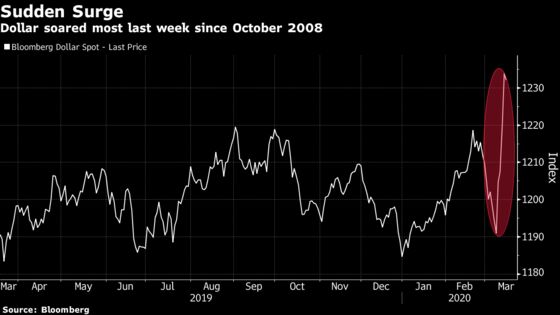Central Banks Coordinate to Boost Global Dollar Liquidity
Fed, Bank of Japan, ECB, Swiss National Bank, Bank of Canada and Bank of England will use swap lines to ensure dollar flow.
(Bloomberg) -- The Federal Reserve and five counterparts united to ensure that dollars keep flowing around the world after the coronavirus emergency sparked a rush for greenbacks.
In coordinated statements on Sunday, the Fed, Bank of Japan, European Central Bank, Swiss National Bank, Bank of Canada and Bank of England said they would use their swap lines to support the international supply of the world’s reserve currency. They added a weekly offering of dollars over a longer maturity, and reduced the cost of the facility.
The aim is to meet the needs of companies and financial institutions rushing for dollars as the global payments system undergoes severe strain due to the coronavirus. The Bloomberg Dollar Spot Index soared the most since the financial crisis in 2008 last week, reflecting enormous demand for the currency.
“For international financial markets, where the U.S. dollar dominates as an international currency, strong U.S. leadership in containing global market disruptions is still essential,” said Shigeto Nagai, chief Japan economist at Oxford Economics in Tokyo, who previously worked at the Bank of Japan. “I initially worried that the U.S.-first Trump administration may hesitate.”

The swaps lines were initiated in 2007 as the credit crisis erupted, starting first with the main developed nation central banks. As pressures on the global system intensified, the Fed expanded the availability to smaller advanced economies and to emerging markets including South Korea and Brazil.
Making dollars available to foreign nations -- even if it didn’t cost the Fed -- became a point of contention for some in the U.S. Congress.
“Good for them to just do the swaps and not apologize,” Adam Posen, who heads the Peterson Institute for International Economics in Washington and was a crisis-era U.K. policy maker, said in a tweet.
The expansion of the swaps line was one of a string of stimulus measures unveiled by the Fed in an emergency move on Sunday. To increase the effectiveness of the facility, the ECB, BOJ and other counterparts will each auction the dollars they get for 84-day terms -- in addition to the current one-week period. The rate was cut by a quarter percentage point, to 25 basis points over the overnight index swap rate.
“The new pricing and maturity offerings will remain in place as long as appropriate to support the smooth functioning of U.S. dollar funding markets,” the joint statement said.
The move won’t immediately help emerging markets also struggling to obtain dollars, with currency depreciation threatening to pile on strains of servicing offshore debt.
“That may add to pain for EM currencies, what with risk already trading weaker post-Fed decision,” said Robin Brooks, chief economist at the Institute of International Finance.
To contact the reporters on this story: Simon Kennedy in London at skennedy4@bloomberg.net;Enda Curran in hong kong at ecurran8@bloomberg.net
To contact the editors responsible for this story: Stephanie Flanders at flanders@bloomberg.net, ;Malcolm Scott at mscott23@bloomberg.net, Christopher Anstey
©2020 Bloomberg L.P.